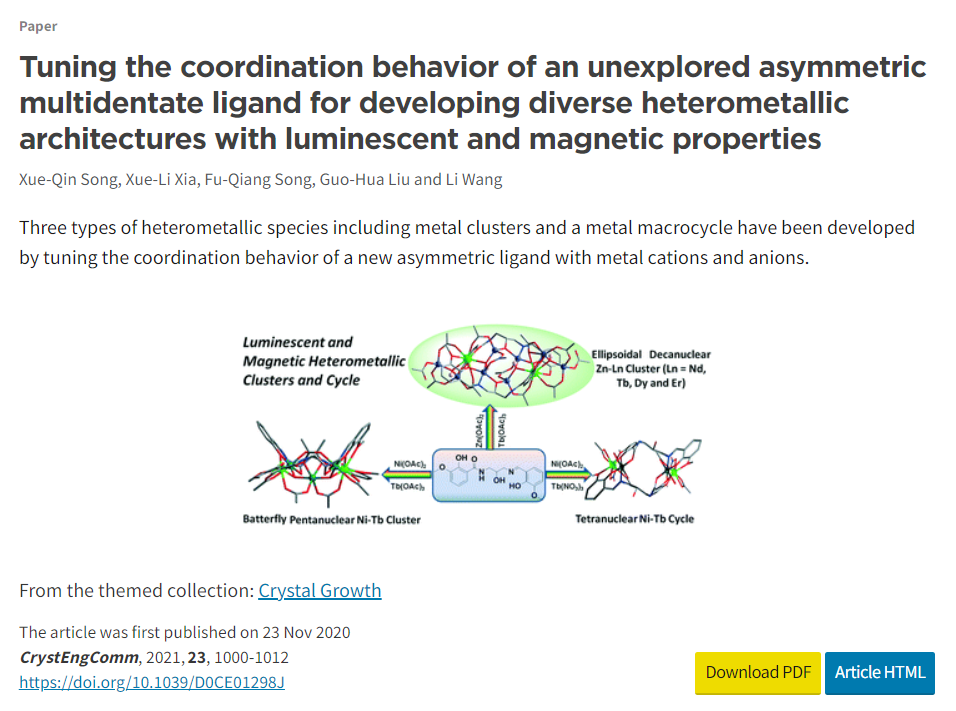songxueqin

|
- Supervisor of Doctorate Candidates
- Supervisor of Master's Candidates
- Name (Pinyin):songxueqin
- Date of Employment:1991-07-26
- Education Level:Postgraduate (Doctoral)
- Degree:Doctoral degree
- Status:Employed
- Teacher College:School of Chemistry and Biological Engineering
 Contact Information
Contact Information
- Telephone:
- Email:
- Paper Publications
Tuning the coordination behavior of an unexplored asymmetric multidentate ligand for developing diverse heterometallic architectures with luminescent and magnetic properties
Release time:2021-05-29 Hits:
- Impact Factor:3.117
- DOI number:10.1039/d0ce01298j
- Affiliation of Author(s):兰州交通大学
- Teaching and Research Group:化学与生物工程学院301室
- Journal:CrystEngComm
- Place of Publication:英国皇家化学会
- Funded by:国家自然科学基金
- Abstract:Recently, by tuning the coordination behavior of a new asymmetric multidentate ligand, H3L, containing two nitrogen and six oxygen donors by both metal centres and anions, H3L = 1-(2-hydroxy-3-methoxybenzamido)-2-(2-hydroxy-3-methoxy-benzylideneamino)-2-hydroxy propane, three types of heterometallic compounds with the chemical composition of [Zn8Ln2L2(OH)4(OAc)12]·xCH3OH·yCH3- CN·zH2O (Zn8Ln2, where Ln = Nd, Tb, Dy and Er), [Ni3Tb2(HL)2(OH)4(OAc)6]·3CH3CN·H2O (Ni3Tb2), and [Ni2Tb2(HL)2(OAc)4(NO3)2(H2O)2]·4CH3CN·3H2O (Ni2Tb2) were developed. Structural analysis revealed that four ellipsoidal decanuclear ZnII–LnIII clusters resulted from the assembly of H3L with Zn(OAc)2·2H2O and Ln(OAc)3·6H2O. Replacement of Zn(OAc)2·2H2O with Ni(OAc)2·4H2O rendered a butterfly pentanuclear NiII–LnIII cluster, and upon further using Tb(NO3)3·6H2O to replace Tb(OAc)3·6H2O, a tetranuclear NiII–LnIII metallocycle was obtained. The luminescence studies on these compounds indicated that the ZnIIcontaining chromophore is a good antenna for sensitizing the characteristic emission of Ln3+ effectively from the visible to near-infrared region as a result of its energy match, perfect shielding and less concentration quenching compared to its NiII analogues, where the d → d transitions characteristic of Ni2+ were observed in the excitation spectra when irradiated. Notably, weak emission bands characteristic of Tb3+ were observed in the spectrum of Ni2Tb2 but not in that of Ni3Tb2 when excited by the d→d transition, which may be attributed to the difference in crystal field. Furthermore, the magnetic susceptibility studies indicate that the magnetic exchange for the TbIII ions in Zn8Tb2, Ni3Tb2 and Ni2Tb2 is ferromagnetic, whereas that for the DyIII ions in Zn8Dy2 is antiferromagnetic. Our results are of great significance for the rational design and synthesis of novel heterometallic supramolecular structures with interesting luminescence and magnetic properties.
- Co-author:刘国华,宋富强,夏雪莉
- First Author:宋学琴
- Indexed by:Journal paper
- Correspondence Author:汪力
- Discipline:Natural Science
- First-Level Discipline:Chemistry
- Document Type:J
- Issue:23
- Page Number:1000-1012
- Translation or Not:no
- Date of Publication:2020-11-20


